# 10 a Martin 00 size guitar. With Strings!
-
John Parchem
- Posts: 2749
- Joined: Fri Dec 23, 2011 8:33 pm
- Location: Seattle
- Contact:
Re: # 10 a Martin 00 size guitar.
I have been making a bit of progress. I have been very busy building the set for my wife's entry into the Seattle flower and garden show so I have not had as much time to post. I have made the fret board, have the neck mortise and tenon finished including having a good neck angle. I am just finishing binding the body. At the moment I am waiting for the glue to set on one of the bindings. For the record I will posts a few pictures from each operations.
This is the first time I slotted a fret board. I actually think it is worth the money to have someone do it for you. It took a bit to get the slots cut and I am still dealing with carpel tunnel in my wrists but here it is.
I used a veritas smoothing plane to get a square edge on the blank this edge became my reference for the rest of the operations.
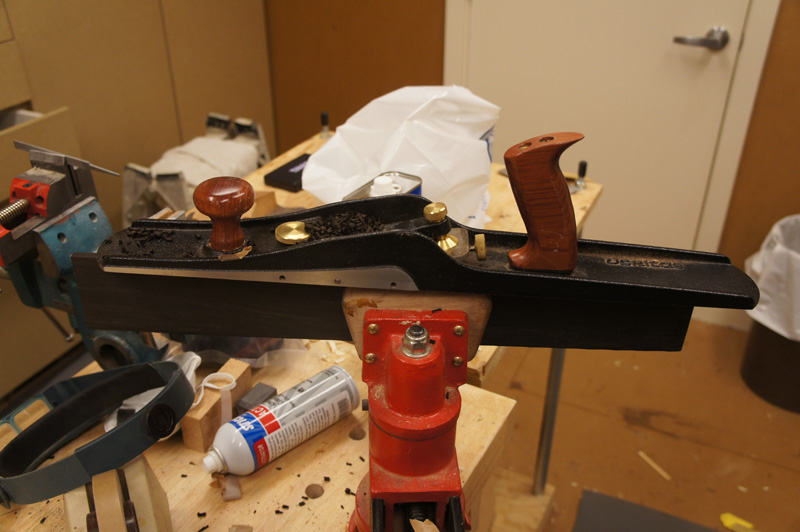
I have an LMI slotting jig and template to cut the slots. The system works really well, and the slots were clean and right on the money. I used windriver plane to rough set the radius to 16" and finished the radius with a stewmac radius sanding block.
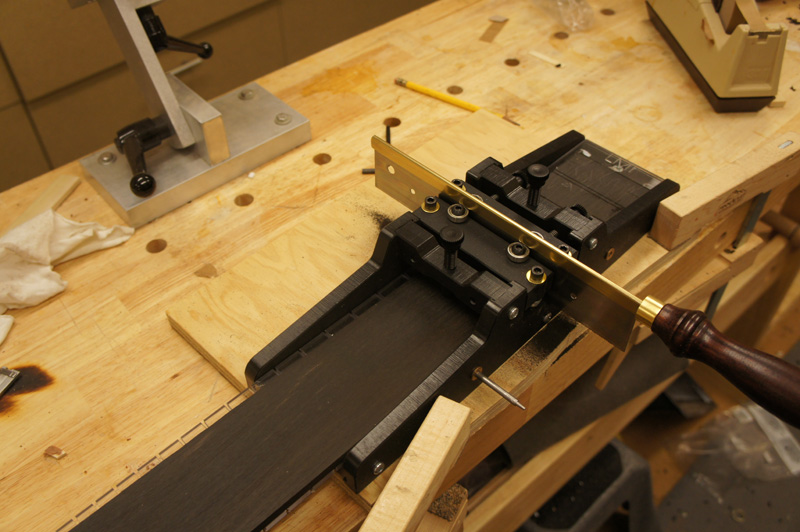
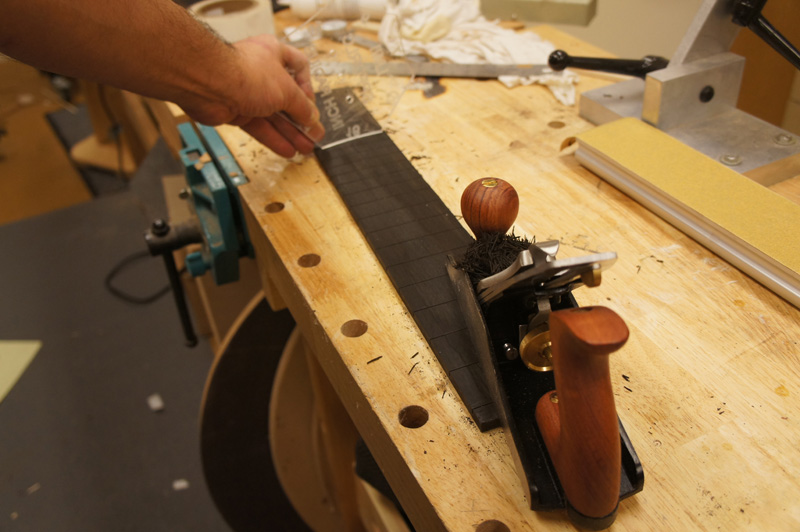
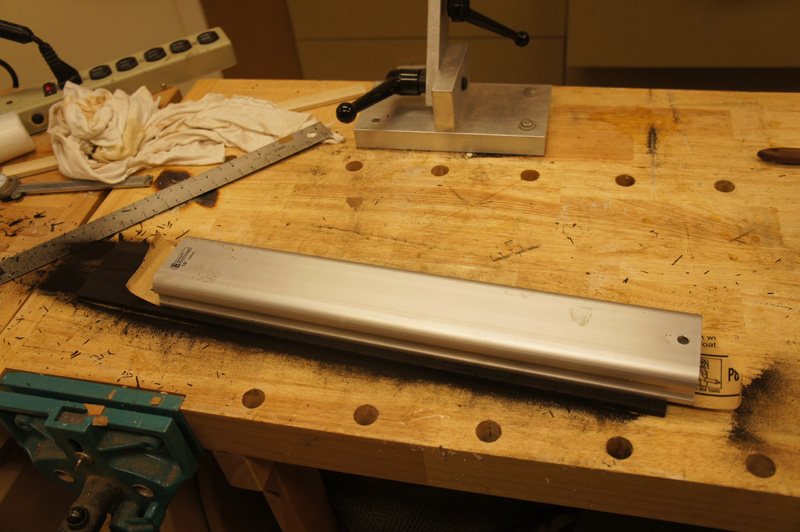
I rough cut the taper on a band saw and cleaned it up with my block plane.
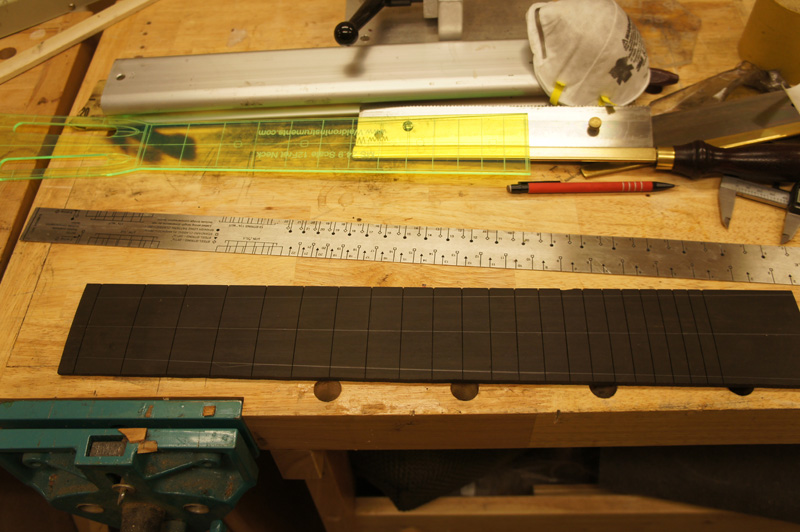
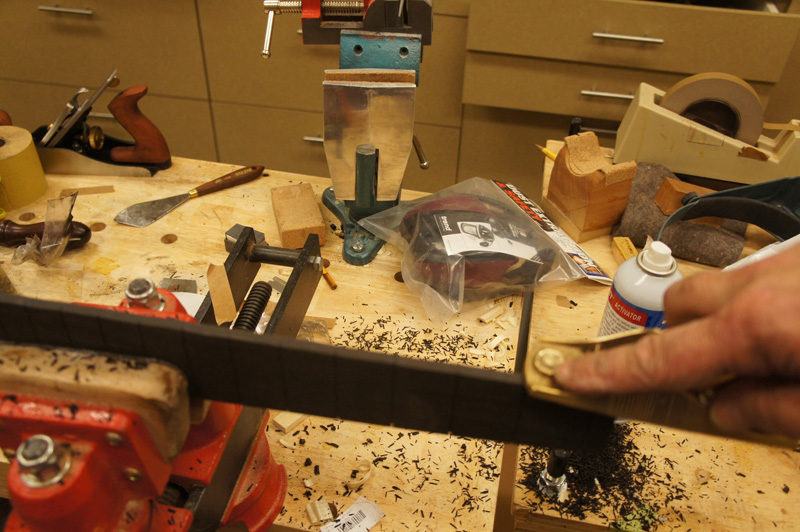
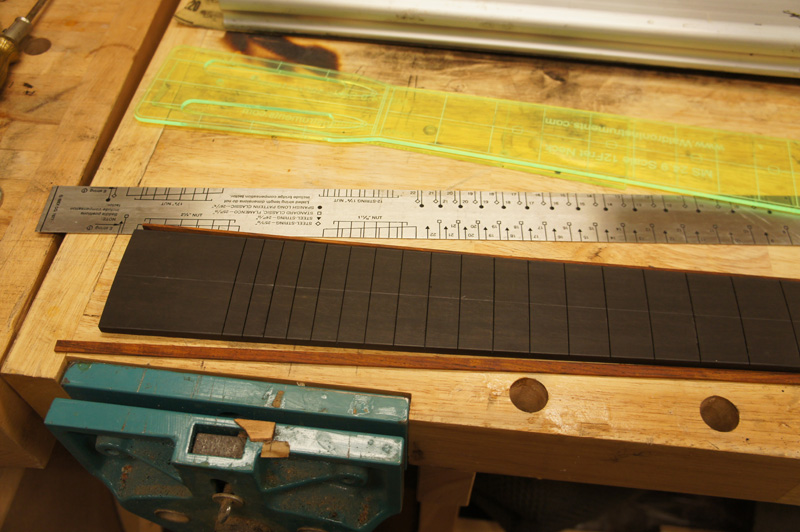
Before I glued on the bindings I used my drum sander to thickness the fret board. I should of done this earlier (like before the radius) But I was unsure how much I would take off radiusing the fret board. All and all it worked out ok.
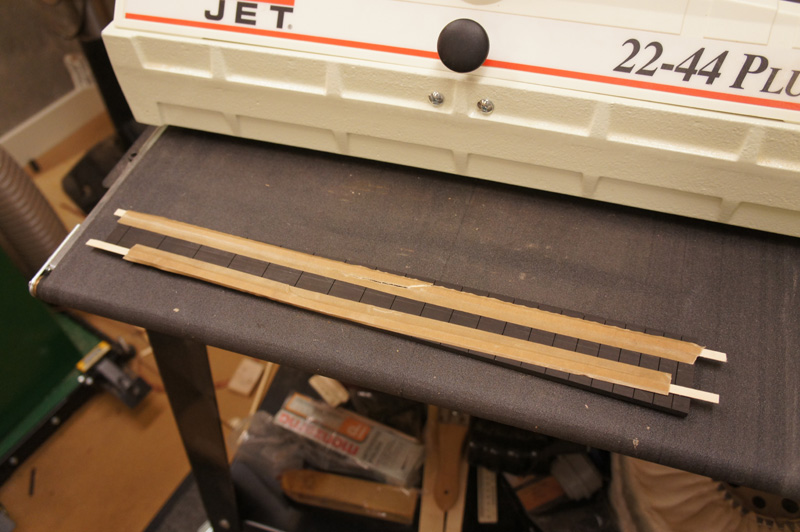
I ended up using LMI glue and taping the binding on the fret board. I use to use thin CA but I have found that thin CA and cocobolo makes a mess.
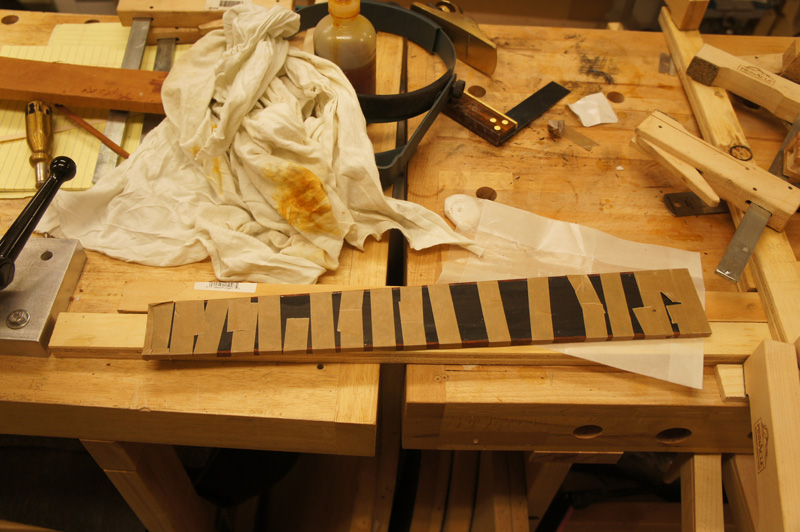
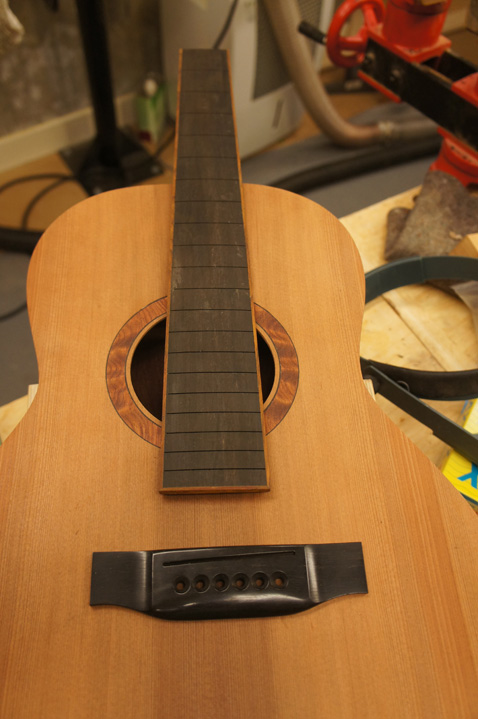
I use a Luthier Tools neck jig to set the neck angle and cut the tenon on the neck and the mortise on the body. I do not set the angle by mounting the body and using the jigs setting tool. Rather I fixed the angle to what I want for the neck. After cracking a tenon once, I now route the bottom of the neck block to the correct length and angle and then install the screw inserts.
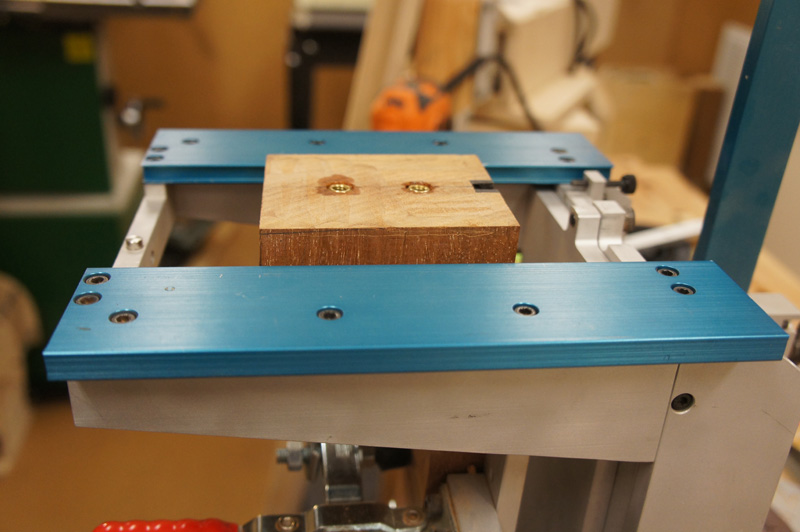
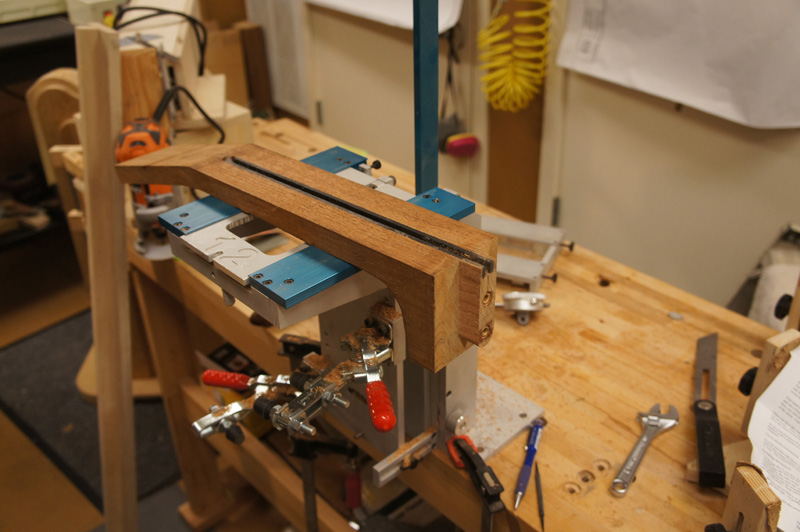
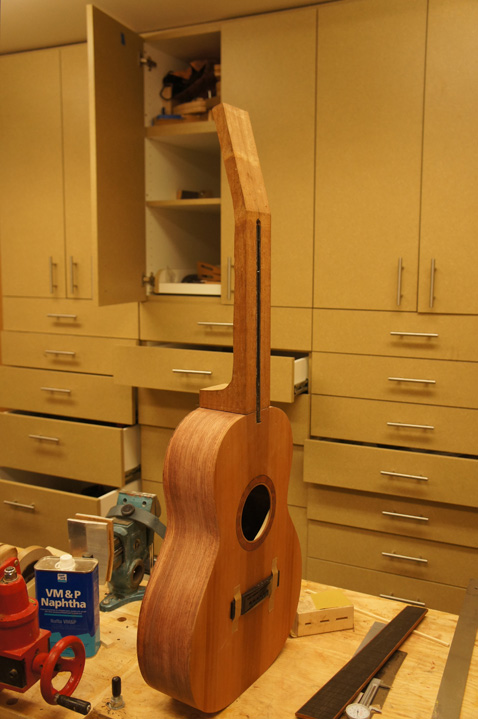
I modified a template that I bought from Waldron instruments to allow me to drill guide pin holes on both the neck face and the fret board. I find it handy to be able to mount the fret board while doing measurements, also These are the guides I use when gluing the fret board on.
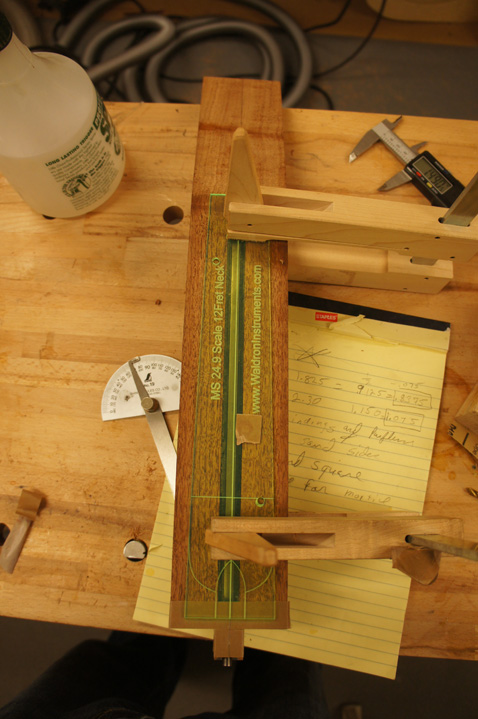
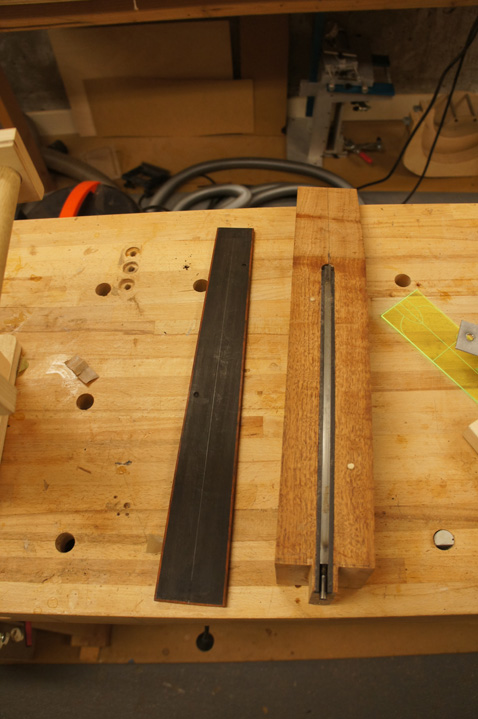
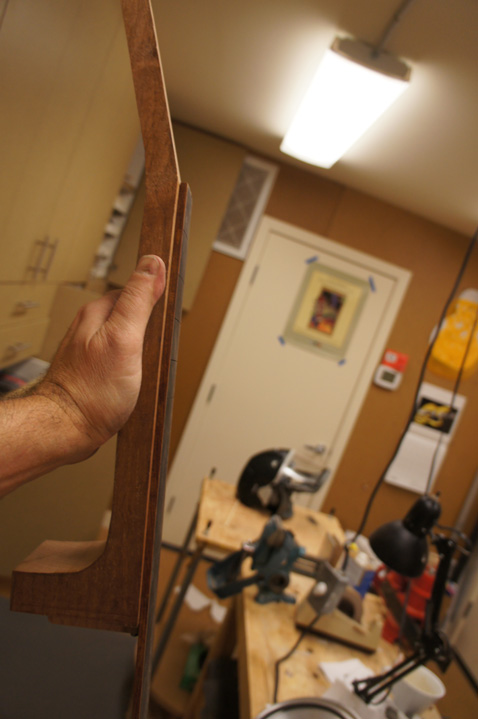
Also I am nearly finished binding the guitar. I taped the whole mess of bindings and purfling (I decided I did not like the look with the purflings) and bend the pile at once. In my bending machine.
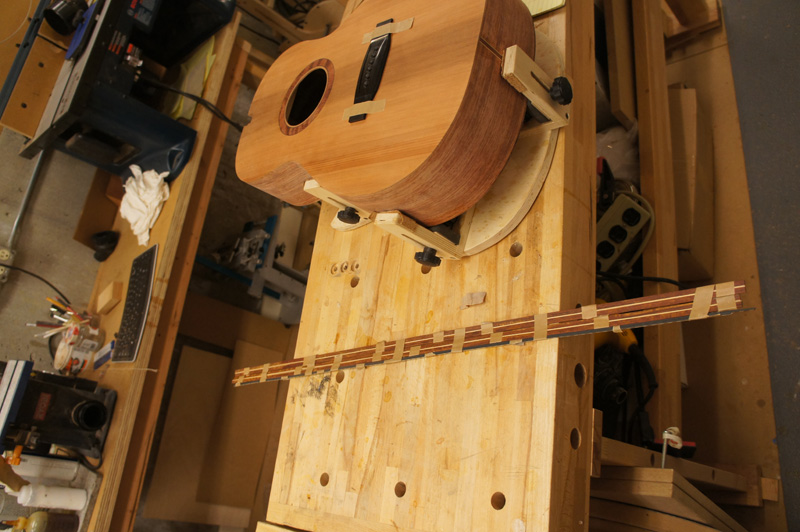
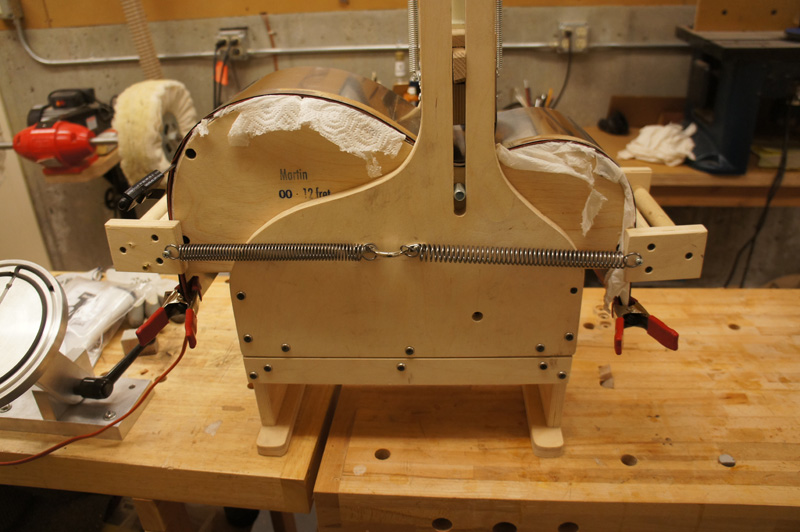
Before routing the binding rebates I taped a bit of purfling to the top and the back to lift the router near the end strip. I finish this section by hand so that I can miter in the this purfling.
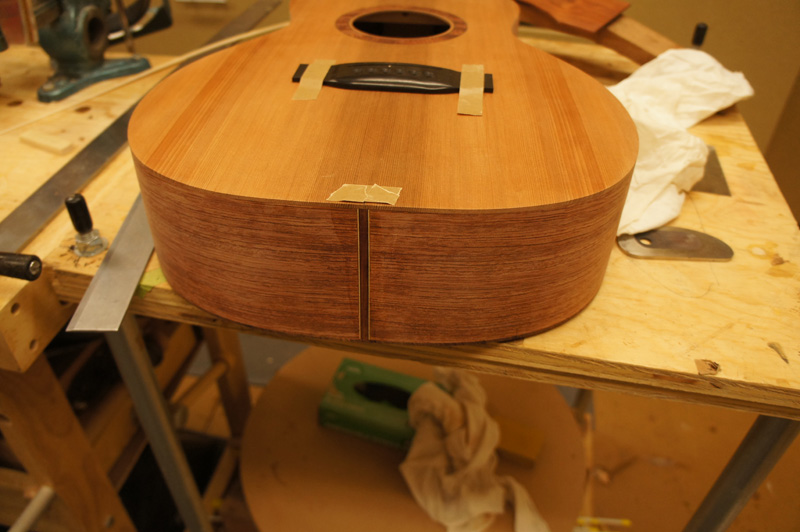
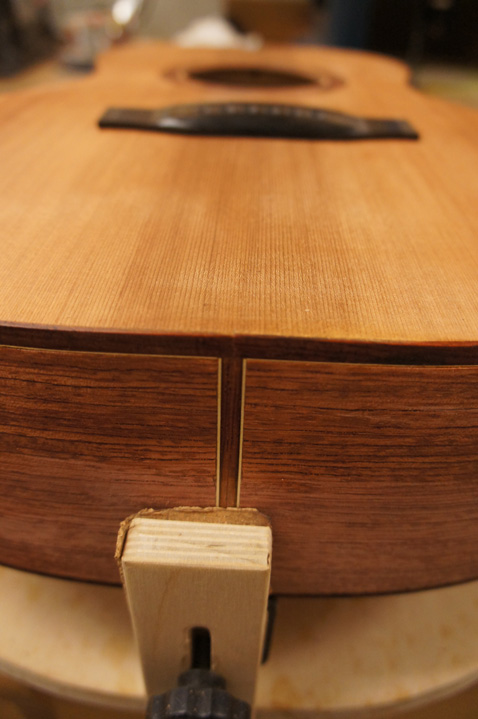
While waiting for the glue on the bindings to cure I have been trying to decide which way I want the pegboard veneer to go. There is a nice horizontal figure that would work both on the bottom or the top.
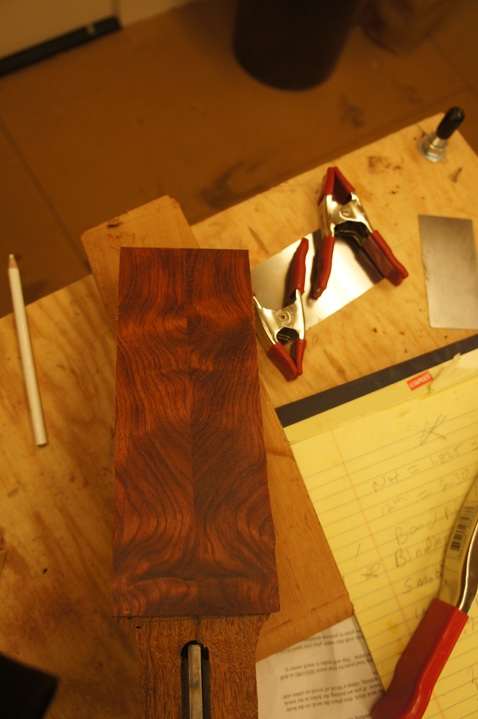
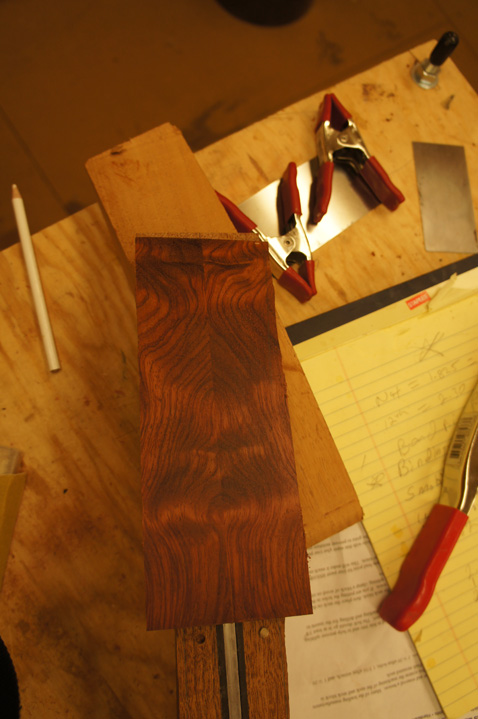
This is the first time I slotted a fret board. I actually think it is worth the money to have someone do it for you. It took a bit to get the slots cut and I am still dealing with carpel tunnel in my wrists but here it is.
I used a veritas smoothing plane to get a square edge on the blank this edge became my reference for the rest of the operations.

I have an LMI slotting jig and template to cut the slots. The system works really well, and the slots were clean and right on the money. I used windriver plane to rough set the radius to 16" and finished the radius with a stewmac radius sanding block.



I rough cut the taper on a band saw and cleaned it up with my block plane.



Before I glued on the bindings I used my drum sander to thickness the fret board. I should of done this earlier (like before the radius) But I was unsure how much I would take off radiusing the fret board. All and all it worked out ok.

I ended up using LMI glue and taping the binding on the fret board. I use to use thin CA but I have found that thin CA and cocobolo makes a mess.


I use a Luthier Tools neck jig to set the neck angle and cut the tenon on the neck and the mortise on the body. I do not set the angle by mounting the body and using the jigs setting tool. Rather I fixed the angle to what I want for the neck. After cracking a tenon once, I now route the bottom of the neck block to the correct length and angle and then install the screw inserts.



I modified a template that I bought from Waldron instruments to allow me to drill guide pin holes on both the neck face and the fret board. I find it handy to be able to mount the fret board while doing measurements, also These are the guides I use when gluing the fret board on.



Also I am nearly finished binding the guitar. I taped the whole mess of bindings and purfling (I decided I did not like the look with the purflings) and bend the pile at once. In my bending machine.


Before routing the binding rebates I taped a bit of purfling to the top and the back to lift the router near the end strip. I finish this section by hand so that I can miter in the this purfling.


While waiting for the glue on the bindings to cure I have been trying to decide which way I want the pegboard veneer to go. There is a nice horizontal figure that would work both on the bottom or the top.


Last edited by John Parchem on Sun Jan 27, 2013 2:32 pm, edited 2 times in total.
-
Dave Bagwill
- Posts: 5951
- Joined: Tue Dec 13, 2011 7:44 pm
Re: # 10 a Martin 00 size guitar.
Another good instructional series John!
-Under permanent construction
Re: # 10 a Martin 00 size guitar.
Fantastic! Thank you for sharing.
George
George
-
Ken Hundley
- Posts: 249
- Joined: Wed Jan 04, 2012 12:18 pm
- Location: Chicago Area
- Contact:
Re: # 10 a Martin 00 size guitar.
Lookin great John! Keep it up!
So, my big brother was playing guitar and I figured I'd try it too.
- Stevie Ray Vaughan
http://www.nocturnalguitars.com
- Stevie Ray Vaughan
http://www.nocturnalguitars.com
-
Kevin in California
- Posts: 2799
- Joined: Mon Dec 19, 2011 4:19 pm
Re: # 10 a Martin 00 size guitar.
Coming along very nicely John. I like the first pic orientation of the headstock veneer.
Kevin
Kevin
-
John Parchem
- Posts: 2749
- Joined: Fri Dec 23, 2011 8:33 pm
- Location: Seattle
- Contact:
Re: # 10 a Martin 00 size guitar.
Finally back to this guitar and on to the neck. I thought I can show how I carved this neck. I find it best to get all of the square dimensions really close before carving.
I roughed out the head stock, In the past I have taped on my template and used a template bit in my router to shape it. Twice now I had the template slip, so this time I cut close with the band saw and cleaned up the edges with a block plane and scraper.
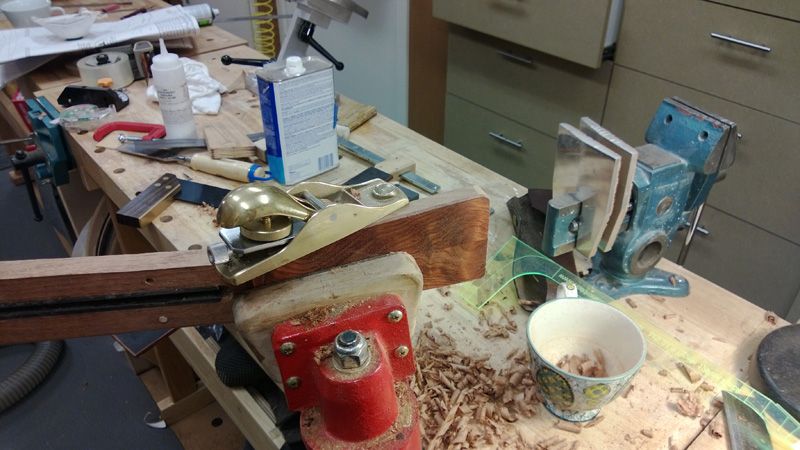
I used my Christmas present to profile the neck to very close to the fret board. I still leave a little to have some working room. But I did get it very close and even.
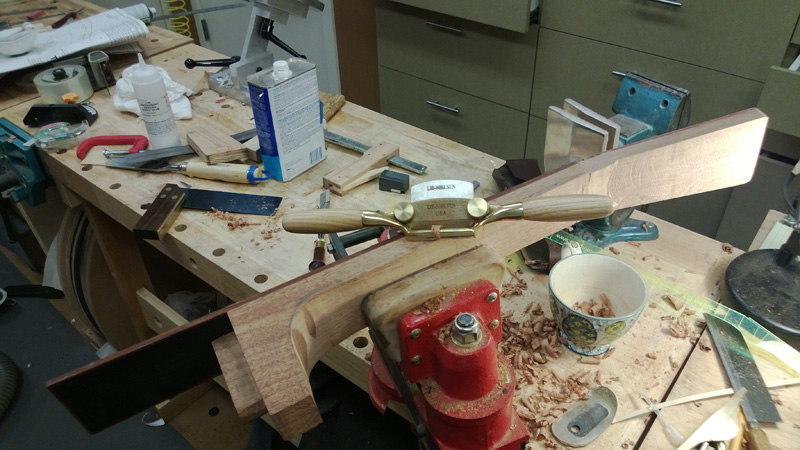
I used my Safe-T planer to take the head stock with the veneer to just proud of 5/8"
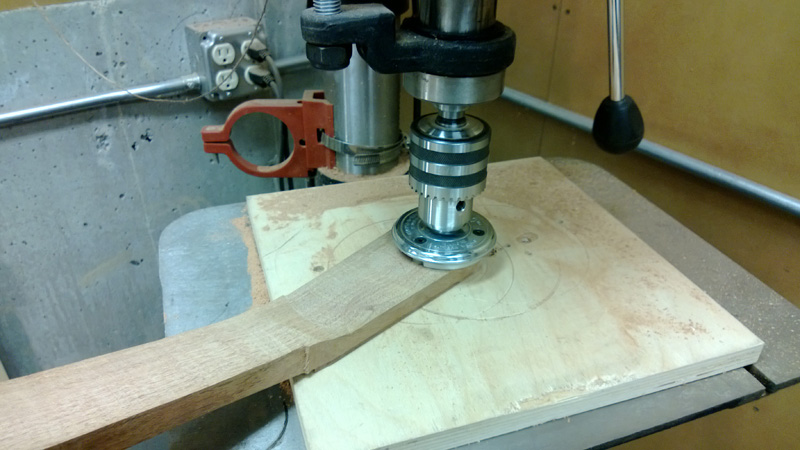
I marked off the neck profile and used a belt sander to get close.
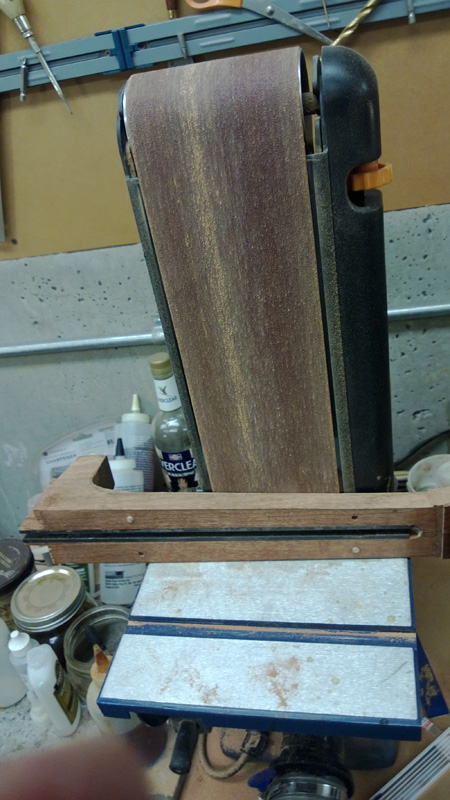
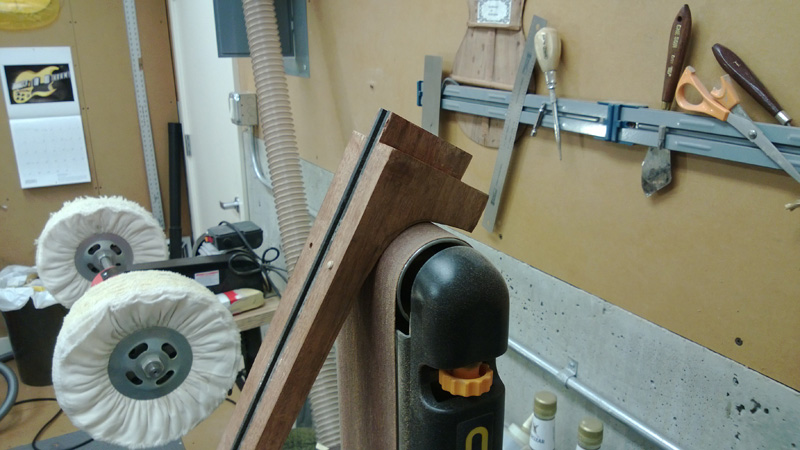
The roughed out neck on the guitar.
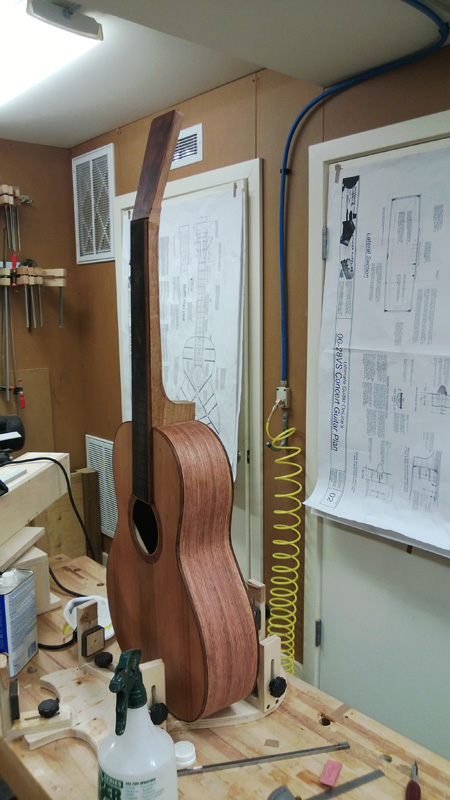
With the neck basically roughed out, I used a template to draw the end cap and on the cheeks the profile of the heel. I also redrew all of my center line to get ready for carving. There are a lot of ways to carve a neck but here is what I found works best for me.
Using only long sweeping strokes, much like one would use a knife, I start removing wood that is farthest from my guide lines on the heel, cheeks and top. The sweeping motion assures that smooth curves are being established. While following the heel and end cap lines I work to the point that I am sort of an even distance away from all of the lines. From that point I just patiently use very long sweeping stokes working one side of the heel toward my guide lines. On the top I look for the carved heel to evenly approach the center line. Doing this most of the curves come naturally as the thickness of the wood changes.
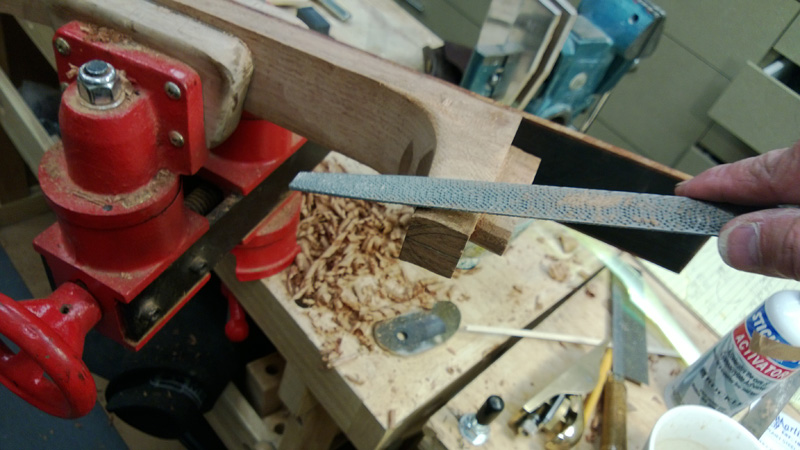

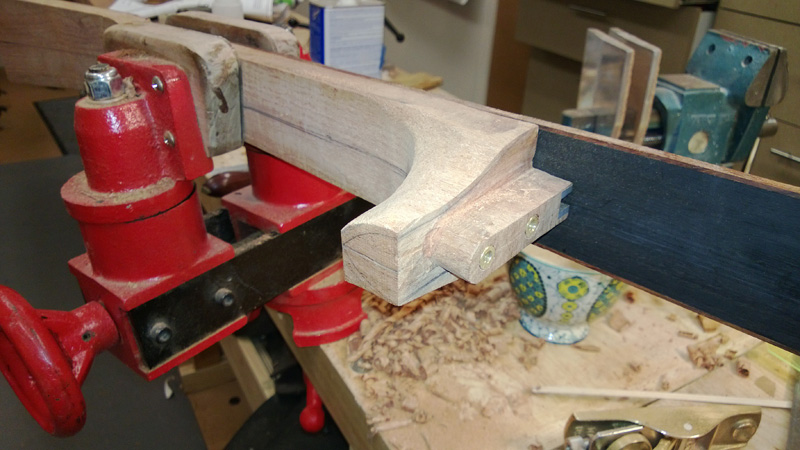
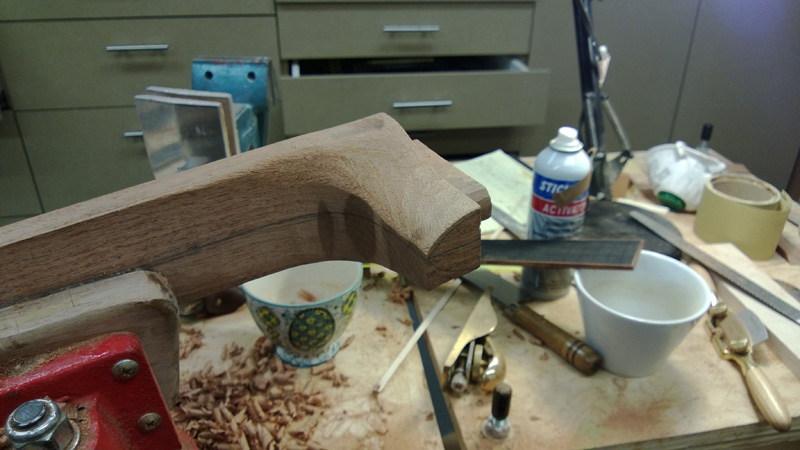
Then I turn it over and do the other side.
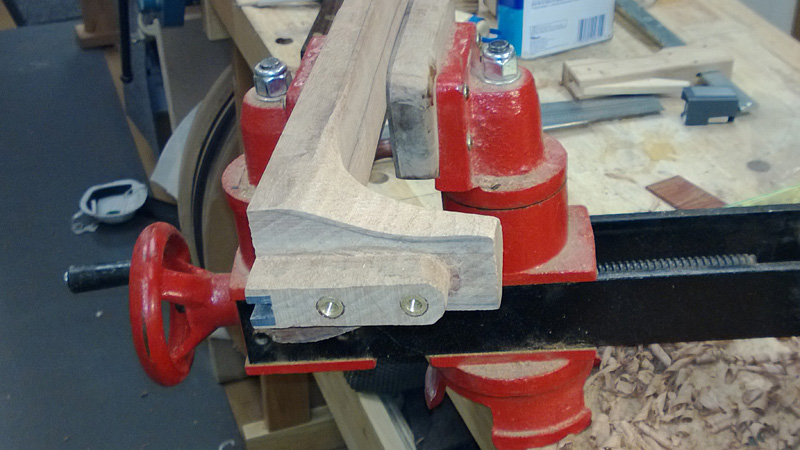
Here is the rough carved heel on the guitar. I will carve the neck after lunch.
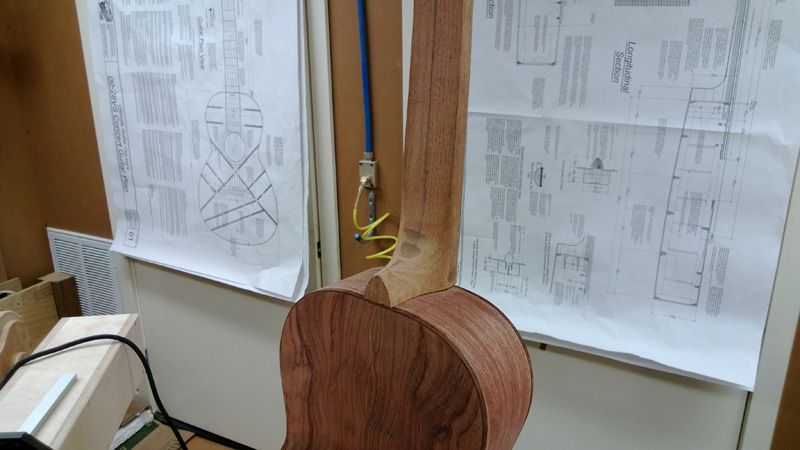
I roughed out the head stock, In the past I have taped on my template and used a template bit in my router to shape it. Twice now I had the template slip, so this time I cut close with the band saw and cleaned up the edges with a block plane and scraper.

I used my Christmas present to profile the neck to very close to the fret board. I still leave a little to have some working room. But I did get it very close and even.

I used my Safe-T planer to take the head stock with the veneer to just proud of 5/8"

I marked off the neck profile and used a belt sander to get close.


The roughed out neck on the guitar.

With the neck basically roughed out, I used a template to draw the end cap and on the cheeks the profile of the heel. I also redrew all of my center line to get ready for carving. There are a lot of ways to carve a neck but here is what I found works best for me.
Using only long sweeping strokes, much like one would use a knife, I start removing wood that is farthest from my guide lines on the heel, cheeks and top. The sweeping motion assures that smooth curves are being established. While following the heel and end cap lines I work to the point that I am sort of an even distance away from all of the lines. From that point I just patiently use very long sweeping stokes working one side of the heel toward my guide lines. On the top I look for the carved heel to evenly approach the center line. Doing this most of the curves come naturally as the thickness of the wood changes.




Then I turn it over and do the other side.

Here is the rough carved heel on the guitar. I will carve the neck after lunch.

